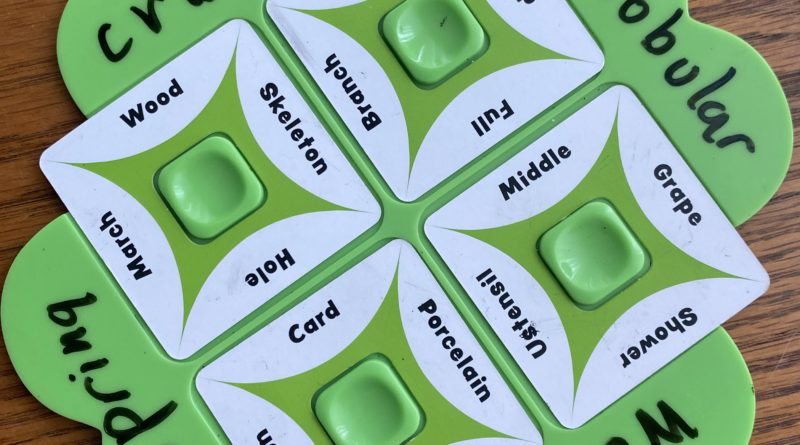Board Game Overview: So Clover!
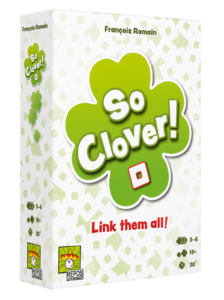 The best party games cultivate conversations that wouldn’t happen without the game there to prompt them. Popular party games like Cards Against Humanity and Exploding Kittens, for example, create wacky, even mildly-offensive moments that break players free from boring chatter. Both are also, at times, quite mean, which is fun most of the time but can become exhausting in large quantities. What if, rather than a little mean, you preferred to be clever? As I see it, the best games structure enjoyment while offering players ways to be creative and, even, damn clever. It’s the last point I want to highlight, for if you like the idea of a game that enables you and your friends/family to bask in each other’s creativity and cleverness, then I’ve got a suggestion for you: So Clover!, designed by François Romain and published by Repos Production in 2021.
The best party games cultivate conversations that wouldn’t happen without the game there to prompt them. Popular party games like Cards Against Humanity and Exploding Kittens, for example, create wacky, even mildly-offensive moments that break players free from boring chatter. Both are also, at times, quite mean, which is fun most of the time but can become exhausting in large quantities. What if, rather than a little mean, you preferred to be clever? As I see it, the best games structure enjoyment while offering players ways to be creative and, even, damn clever. It’s the last point I want to highlight, for if you like the idea of a game that enables you and your friends/family to bask in each other’s creativity and cleverness, then I’ve got a suggestion for you: So Clover!, designed by François Romain and published by Repos Production in 2021.
So Clover! is a cooperative word game where players work together to link and decode one word clues. It’s delightful because it’s easy to teach and to play, rewards players for being proficient with their word play and for knowing their audience, and moves quickly. If you’ve played Apples to Apples, you know the joy of playing the perfect red noun card from your hand that matches the green descriptive card held by the active player, and you’ll already have a sense of the delights offered by So Clover! On the other hand, if you’ve been that active player, holding a green card and looking at a few reds that leave you wondering “what on earth was that person thinking?!”—then you’ve tasted some of what makes So Clover! tick.
Let me teach you how to play, with some pictures. Each player receives a nice chunky green plastic four leaf clover and a small dry-erase marker. You’ll then each get four unique square cards with a hole in the middle. Keep your four cards face down until it’s time for everyone to begin. Then, flip them over and randomly place them on your clover. (Note that you have to do this randomly. You aren’t supposed to spin them to make it easier). Now the fun begins. Let’s say mine looks like this:

My task is to write a single word above each pair of words, in what the rulebook calls the “clue zone” but which I think of as “clover bumps.” The word we choose should link the two words together in a way that will enable other players to see the link and, ultimately, put our square cards back together exactly the way we see them. The rulebook gives this helpful, simple example:
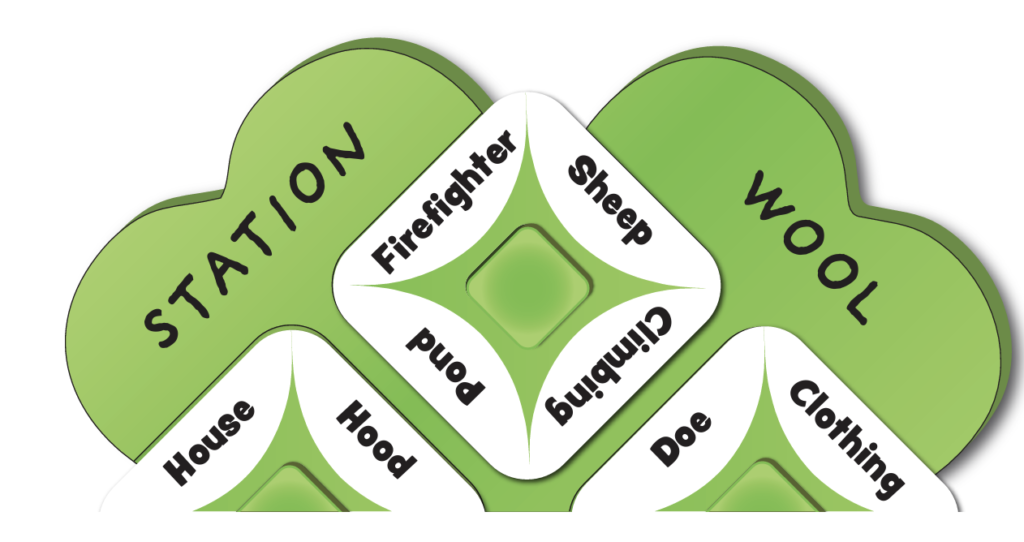
Ok, “STATION” links “House” and “Firefighter” and “WOOL” links “Sheep” and “Clothing.” That makes sense! But what about my example above? Here’s what I came up with:

I did my best! I found “Season” and “March” pretty easy to link with with the word “SPRING,” and “Shower” and “Pump” work pretty well linked by “WATER.” “Wood” and “Quilt” was a bit hard, but I went with “CRAFTING” since those are both things you might use and/or produce while crafting. I first thought of “craft,” but decided to add the gerund to make it more specific. “GLOBULAR” for “Grape” and “Soap” was my really tough one, but I’m hopeful that it makes enough sense for the folks I’m playing with to figure out.
While I link my words, other players do the same, taking care not to let others see their clover (honestly, this is easy since everyone is so busy thinking about their own links). Once we’re all ready, everyone will flip over their clover, turning their cards upside down. Then—and this is a little diabolical, but it’s necessary—each player will add a fifth card to their small stack, then take turns revealing their clover and their cards. So, once its my turn, I will show this to my fellow players:
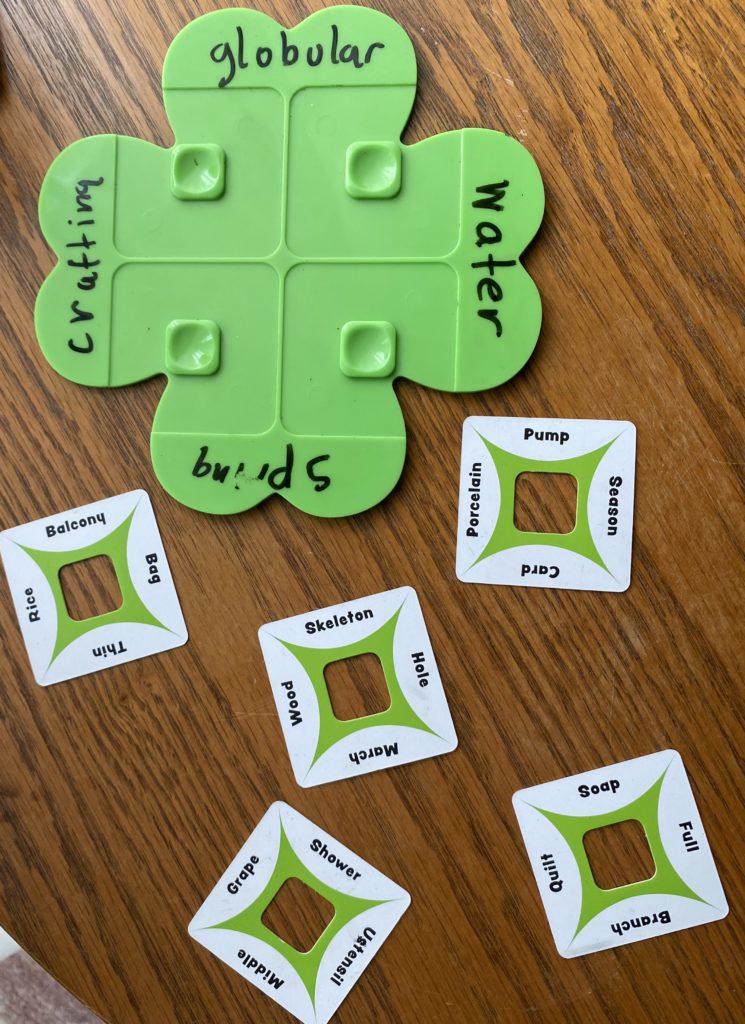
And their task will be to put it back together. At this point, I become a Spectator: I cannot say anything, give a thumbs-up or down, make any weird faces, etc. They have to put the pieces together. At this point, players collaborate, trying to figure out what my clover looked like as I was linking words. After they discuss it and unanimously decide to “submit” their guess, I will let them know how they did. Perhaps they’ll submit something that looks like this:
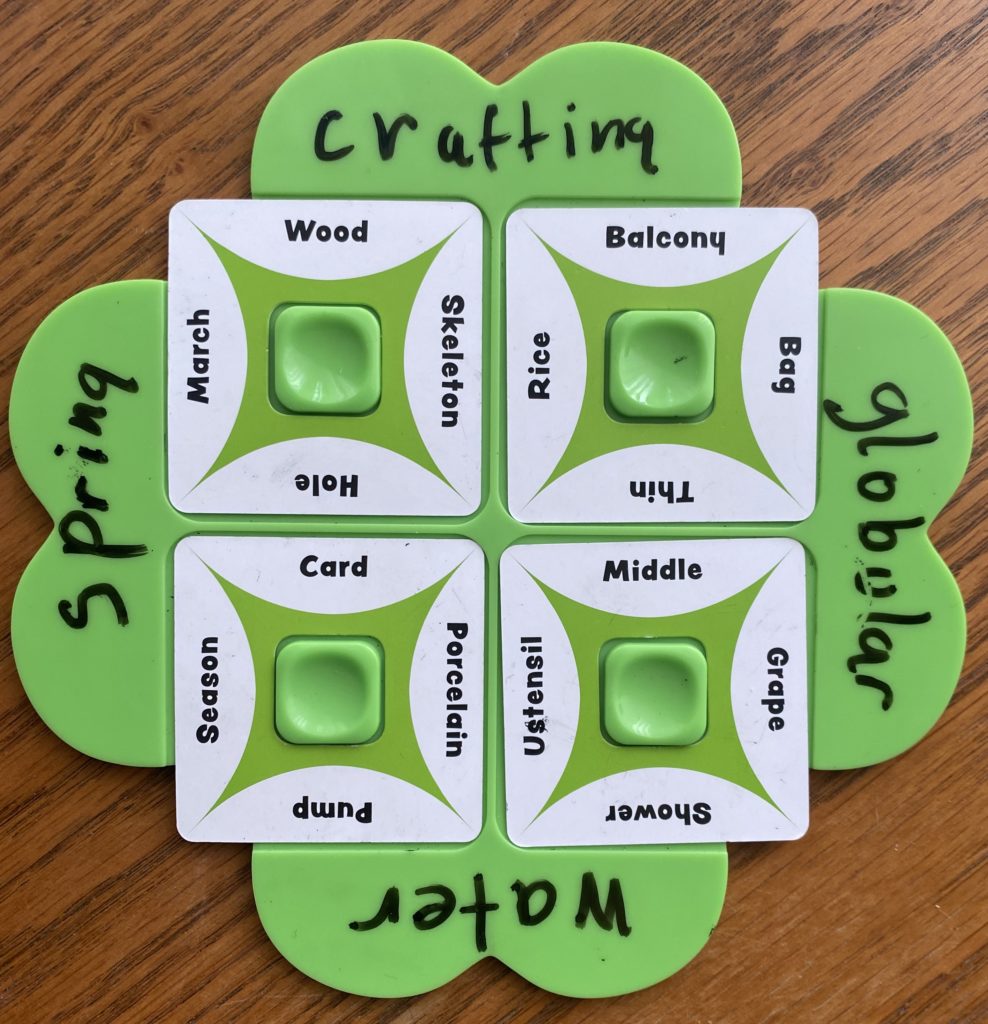
Pretty close! I can see how they got confused by “GLOBULAR” and how “Bag” made sense there, just like “Balcony” works with “Wood” in the sense that you could be crafting a balcony made of wood. I would then take that card off, letting players know that everything was spot on except for that one card, and then they’d have one more chance to try again.
That’s it! That’s how So Clover! works. If you want, you can keep score, and the game includes rules for how to do that, but it’s not really important. Everyone takes a turn revealing their clover, and everyone else takes turns trying to put it together, and everyone has a good time.
While this is not a strategy game, it’s definitely one that rewards cleverness—as long as you’re not being too clever or misreading your audience. I once thought I was being so smart linking “Cross” and “Hill” with the word “CALVARY,” only to have the person I was playing with read my clue as the more familiar word “cavalry,” meaning they started thinking about armies on horseback and didn’t pick up on my hyper-specific reference steeped in the language of Christianity. Rather than so clever, I had been too clever, and my link misfired. Knowing your audience is key!
So Clover! is a great party game. You can play with up to 6 players in less than 30 minutes. Kids can play, boomers can play, slightly inebriated people can play. I’ve yet to introduce it to people who didn’t love it and immediately want to play another round. It combines fun tactile pieces like chunky plastic clovers and mini dry erase markers with abstract, allusive word linkages. Sometimes you will link two words and look on in triumph as your fellow players immediately put the pieces together and say “that’s great!” and sometimes you will stare silently at them, raging over the fact that they failed to recognize your clear allusion to a Dragon Ball Z episode they obviously haven’t seen (recently). Either way, you’ll have a blast.
So Clover! retails for $25 MSRP, and you can easily find it at your favorite online board game retailer

